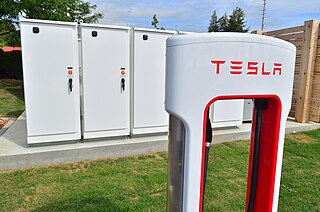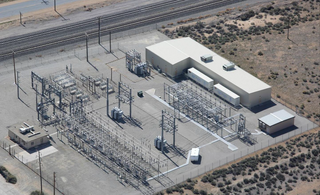
A sodium–sulfur (NaS) battery is a type of molten-salt battery that uses liquid sodium and liquid sulfur electrodes. This type of battery has a similar energy density to lithium-ion batteries, and is fabricated from inexpensive and non-toxic materials. However, due to the high operating temperature required, as well as the highly corrosive and reactive nature of sodium and sodium polysulfides, these batteries are primarily suited for stationary energy storage applications, rather than for use in vehicles. Molten Na-S batteries are scalable in size: there is a 1 MW microgrid support system on Catalina Island CA (USA) and a 50 MW/300 MWh system in Fukuoka, Kyushu, (Japan).

Southern California Edison (SCE), the largest subsidiary of Edison International, is the primary electric utility company for much of Southern California. It provides 15 million people with electricity across a service territory of approximately 50,000 square miles.

Grid energy storage is a collection of methods used for energy storage on a large scale within an electrical power grid. Electrical energy is stored during times when electricity is plentiful and inexpensive or when demand is low, and later returned to the grid when demand is high, and electricity prices tend to be higher.

The Moss Landing Power Plant is a natural gas powered electricity generation plant located in Moss Landing, California, United States, at the midpoint of Monterey Bay. Its large stacks are landmarks, visible throughout the Monterey Bay Area. The plant is owned and operated by Houston-based Dynegy and currently has a generation capacity of 1020 MW (net) from its two combined cycle generation units. It was once the largest power plant in the state of California, with a generation capacity of 2560 MW, before its two large supercritical steam units were retired in 2016.

The AES Corporation is an American utility and power generation company. It owns and operates power plants, which it uses to generate and sell electricity to end users and intermediaries like utilities and industrial facilities. AES is headquartered in Arlington, Virginia, and is one of the world's leading power companies, generating and distributing electric power in 15 countries and employing 10,500 people worldwide. AES Corporation is a global Fortune 500 power company. AES Ranks in the Top Ten of Fast Company's 2022 Best Workplaces for Innovators.

Coryton Power Station is a 732 MW Combined Cycle Gas Turbine (CCGT) gas-fired power station at Coryton, Thurrock, Essex, UK.

The energy sector in Hawaii has rapidly adopted solar power due to the high costs of electricity, and good solar resources, and has one of the highest per capita rates of solar power in the United States. Hawaii's imported energy costs, mostly for imported petroleum and coal, are three to four times higher than the mainland, so Hawaii has motivation to become one of the highest users of solar energy. Hawaii was the first state in the United States to reach grid parity for photovoltaics. Its tropical location provides abundant ambient energy.

Imperial Valley Geothermal Project is a complex of eleven geothermal power stations located in the Salton Sea Geothermal Field, along the southeastern shore of the Salton Sea in the Imperial Valley of California. It is the second largest geothermal field in the United States after The Geysers in Northern California.
Cryogenic energy storage (CES) is the use of low temperature (cryogenic) liquids such as liquid air or liquid nitrogen to store energy. The technology is primarily used for the large-scale storage of electricity. Following grid-scale demonstrator plants, a 250 MWh commercial plant is now under construction in the UK, and a 400 MWh store is planned in the USA.

The electricity sector in Australia has been historically dominated by coal-fired power stations, but renewables are forming a rapidly growing fraction of supply. In 2021, Australia's electricity production reached 265 TWh, with coal accounting for 52.9% and natural gas for 18.8%. Renewable sources, comprising solar, wind, hydro, and bioenergy with waste, collectively made up 26.7% of the total electricity generation mix.

The Tesla Powerpack was a rechargeable lithium-ion battery stationary energy storage product, intended for use by businesses or on smaller projects from power utilities. The device was manufactured by Tesla Energy, the clean energy subsidiary of Tesla, Inc. The Powerpack stores electricity for time of use load shifting, backup power, demand response, microgrids, renewable energy integration, frequency regulation, and voltage control. The first prototype Powerpacks were installed in 2012 at the locations of a few industrial customers. After July 22, 2022, the product was no longer listed for sale.
Younicos was a German-American technology company that developed and sold energy storage systems and control software. The company integrated battery technologies, power electronics and control software to create systems that respond to the energy management requirements of power networks of all sizes, including micro-grids.

A battery storage power station, or battery energy storage system (BESS), is a type of energy storage power station that uses a group of batteries to store electrical energy. Battery storage is the fastest responding dispatchable source of power on electric grids, and it is used to stabilise those grids, as battery storage can transition from standby to full power in under a second to deal with grid contingencies.
Energy in the Faroe Islands is produced primarily from imported fossil fuels, with further contributions from hydro and wind power. Oil products are the main energy source, mainly consumed by fishing vessels and sea transport. Electricity is produced by oil, hydropower and wind farms, mainly by SEV, which is owned by all the municipalities of the Faroe Islands. The Faroe Islands are not connected by power lines with continental Europe, and thus the archipelago cannot import or export electricity.
Hornsdale Power Reserve is a 150 MW grid-connected energy storage system owned by Neoen co-located with the Hornsdale Wind Farm in the Mid North region of South Australia, also owned by Neoen.

The Tesla Megapack is a large-scale rechargeable lithium-ion battery stationary energy storage product, intended for use at battery storage power stations, manufactured by Tesla Energy, the energy subsidiary of Tesla, Inc.

The Tehachapi Energy Storage Project (TSP) is a 8MW/32MWh lithium-ion battery-based grid energy storage system at the Monolith Substation of Southern California Edison (SCE) in Tehachapi, California, sufficient to power between 1,600 and 2,400 homes for four hours. At the time of commissioning in 2014, it was the largest lithium-ion battery system operating in North America and one of the largest in the world. TSP is considered to be a modern-day energy storage pioneer with significant accomplishments that have proven the viability of utility-scale energy storage using lithium-ion technology. While originally envisioned as a research and development project, TSP operated as a distribution-level resource for SCE and for calendar year 2020, SCE reported that TSP operated in the wholesale energy market with revenue exceeding operating and maintenance costs. In 2021, SCE began the decommissioning of TSP, which was followed by formal decommissioning by state regulators in 2022. The physical dismantlement of TSP is expected to be completed by the end of 2022.
The Victorian Big Battery is a grid-connected battery electricity storage facility adjacent to the Moorabool Terminal Station (substation) near Geelong in Victoria, Australia. The battery provides 450 MWh of storage and can discharge at 300 MW. It surpasses the 250 MWh Gateway Energy Storage in California, United States. As of December 2021, the project is the largest lithium-ion battery in the Southern Hemisphere.












